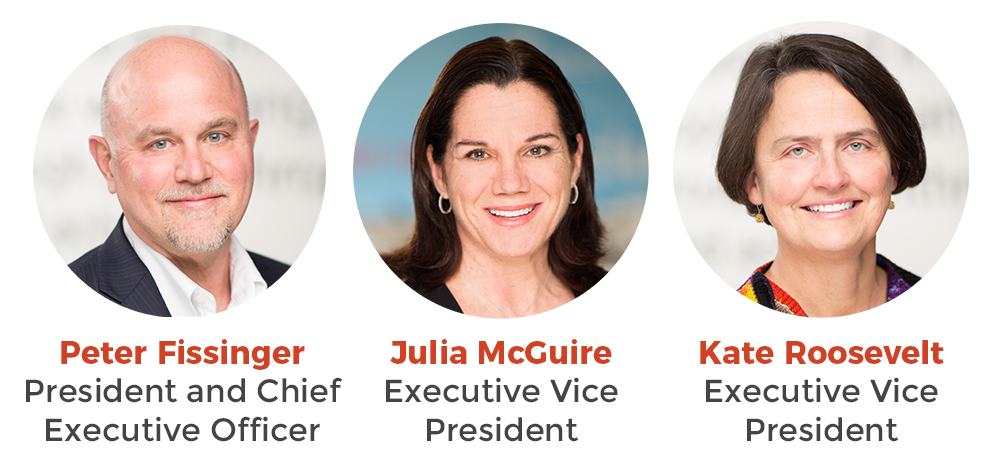

After an unprecedented and unpredictable 2020, what’s in store for 2021? Our executive team came together to share their reflections, forecasts, and advice for the coming year.

Read on for Peter, Julia, and Kate’s perspective on the effects of the pandemic, the racial justice movement, the economic downturn, and more.
Julia: I’m closely watching acquisition of new donors and retention of mid-level donors. The economic impact of the pandemic has hit average Americans much harder than the wealthy, and the recovery will likely be just as uneven. Because of this, I’m tuned into donors lower on the pyramid. They will be the pipeline for future philanthropy.
Kate: I am also watching how organizations and funders move from reactive relief mode to recovery mode. For so many months, they have been responding to the immediate effects of the pandemic and the Movement for Black Lives. What will the next phase look like? Where will dollars flow, and how will organizations shift their messaging and programming?
Peter: Building on that: What has changed forever in how organizations position themselves, how they raise money, and how they connect with donors? And what will, over time, revert to patterns we saw before the pandemic and economic downturn? We’ve experienced a very unusual year, and I am watching to see what adaptations are here to stay.
Kate: So many more nonprofits are now thinking about their work in the context of addressing systemic racism, and I believe that will be a lasting change. It feels to me like a fundamental tectonic shift.
Peter: “Necessity is the mother of invention” has never been truer than this year. Organizations and people learned to adapt to circumstances they had not experienced before—the most obvious being lack of face-to-face interactions.
There are so many examples. We’ve seen food banks adjust to not only continue to deliver food but deliver food in record amounts. Educational organizations have managed to cope with remote learning and hybrid models. There’s been some trial and error, but overall, it’s been a remarkable testament to the resilience of humanity and philanthropy.
Kate: We’re also seeing groups band together and work in coalitions in ways they haven’t before. In Washington state, these sorts of unprecedented partnerships have emerged between food distribution organizations. Northwest Harvest and Food Lifeline, a Feeding America affiliate, have worked with the state government and other nonprofits to mobilize more dollars to feed hungry people and to strengthen their supply chain.
On the philanthropy side, community foundations have stepped up in a very important way. In many cities and towns, they are the hub of knowledge about how the pandemic is affecting the community. So many community foundations launched and managed COVID relief funds and are now gradually moving into the recovery phase.
Beyond that, so many organizations have adapted their engagement, communications, and fundraising practices. After the initial panic passed, people dug in and said, “Okay, we have to do a virtual gala. Let’s figure out how to do that.” There was a lot of trial and error and embracing of new and different ways to create community.
Julia: The acceleration of technology use has been remarkable. Arts and cultural organizations are engaging and mobilizing their audiences with creative virtual content when they cannot gather in person. Across sectors, organizations are using technology in new ways to work with remote teams, deliver programs, and reach donors and stakeholders.
I don’t think this will end, and that’s why it is so important for fundraisers to be able to engage through technology. In the past, if it wasn’t easy to have a cup of coffee with a donor or invite them to an in-person event, we might not give that donor the time and attention they deserve. When we can engage with donors regardless of their location, it opens up a larger world, particularly for national organizations and for educational institutions.
Kate: Many smaller grassroots organizations that are led by and serving BIPOC communities are really struggling to keep up with the surge of donations they’re receiving. This added pressure to be responsive and keep new donors engaged can be stressful.
Over the summer, I came across a statement that urged donors supporting Black-led organizations to make a five-year pledge. That way, the organization knows that you’re going to support them, not just in this moment, but next year, the year after that, and so forth. It’s so important to recognize that organizations on the frontlines need long-term commitments from the philanthropic community to do their work well.
The annual fundraising cycle can create a burden on organizations that are working around the clock to ensure people’s basic needs are met and that those who’ve traditionally been ignored in our communities receive the attention and resources they deserve.
Peter: To add on, we’ve seen major foundations and philanthropic organizations proactively funding initiatives related to racial equity. Bloomberg Philanthropies’ $100 million commitment to four historically Black medical schools is a great example.
In that case, Bloomberg Philanthropies wanted to address racial disparities in health outcomes and sought out this coalition of schools. It’s an interesting flip side to what Kate described at the grassroots level, and it is another way things have changed somewhat.
Julia: We’re seeing more and more philanthropists—like Bloomberg—trying to make systemic change, and we’ve seen a larger investment in systemic change on many levels. Increasingly, grantmakers are actively seeking out BIPOC-led and BIPOC-serving organizations.
Kate: The last thing I’ll mention is the change in conversations we’re having with clients and prospective clients. So many more organizations are putting an emphasis on racial equity, anti-racism, and addressing systemic racism.
Across the sector, we’re seeing an uptick in groups that are centering this work, which will then influence their fundraising and communications efforts going forward—and we hope to help make lasting change.
Peter: Unlike the Great Recession and most recessions we’ve experienced, the S&P 500 and stock market have continued to soar while unemployment and other indicators have suffered significantly.
We have seen broad-based giving spike, and many large gifts have made headlines this year. There is evidence that giving has sustained. It may have even slightly increased, but it’s hard to know for sure. Many Americans are facing unprecedented challenges while many of those with invested assets are wealthier than ever.
Kate: This sits squarely in the conversation that we’re having in this country about income inequality. It’s tricky to predict, but it could very well be that we see the total amount of giving go up this year. At the same time, the number of donors could continue to decrease, given the enormous economic pressures that the average American is facing.
Julia: These dynamics also influence the demands on nonprofits. If you’re looking at human service organizations, the need is not going to go away in six months, even if everyone is vaccinated. That rebuilding is going to take some time, and that’s why I am watching the donor pipeline for the future.
Peter: Continue to be bold about your case: how you are addressing important needs in the community and providing a valuable service.
For organizations receiving an influx of first-time gifts, acknowledge and try to retain these donors to build a pipeline of supporters. For all organizations, recognize that donors with invested assets have the ability to give and ask them to continue to increase their support.
There are so many fundamentals that I urge organizations to focus on: case for support, donor recognition and retention, and relationship building with major gift prospects and major gift donors.
Julia: To build on that, I would say absolutely continue to embrace technology. Don’t think that this was just a temporary bridge to get us back to normal. In fact, build on all the pieces of your work that this process has accelerated, from the use of technology to engage stakeholders to the increased emphasis on racial equity.
Traditionally, the nonprofit world is not known for being quick on its feet, but we were very responsive in 2020.
Kate: To close us out, we have a responsibility to show the rest of the world what it looks like to make a place at the table—or even give up your seat at the table—so it can be occupied by a leader of color. Better yet, leaders of color.
In 2021, I encourage nonprofit organizations to show people what it looks like to diversify their staff and board, what it looks like to engage the community in an inclusive way, and what it looks like to promote equity.